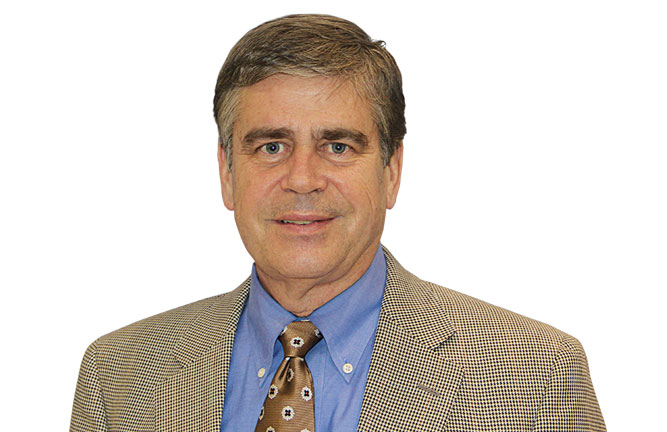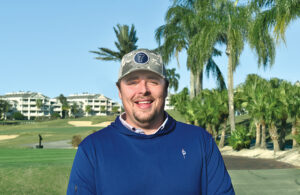PBI-Gordon’s Dale Sanson discusses SpeedZone and its influence on golf
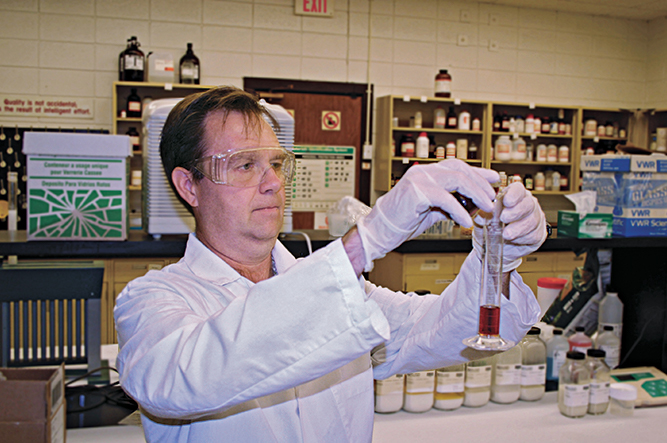
Dale Sanson, Ph.D., scientist for PBI-Gordon (Photo courtesy of PBI Gordon)
Dale Sanson, Ph.D., has worked for Kansas City-based PBI-Gordon for more than 25 years. Sanson oversees four laboratories as the senior director of formulation development and compliance chemistry, and has had his hands in the formulation of dozens of professional turf chemistries, such as Kabuto, Tekken and Trimec.
Golfdom caught up with Sanson over Zoom to discuss his career at PBI-Gordon, what it’s like to have his job and how it feels to see a chemistry go from a concept to a solution for the end user.
Golfdom: Dr. Dale, it’s great to see you, thanks for taking the time to chat.
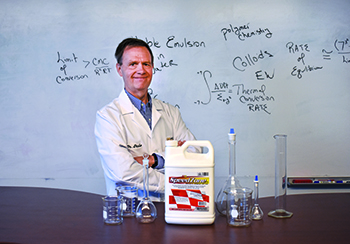
Dale Sanson, Ph.D., discusses PBI-Gordon’s SpeedZone herbicide (Photo courtesy: PBI-Gordon).
Dale Sanson, Ph.D.: It’s always a pleasure to talk business and formulation chemistry with those in the field.
Golfdom: You know I’m always talking formulation chemistry. Tell us about what you do for PBI-Gordon.
Sanson: I’ve been with PBI-Gordon for a quarter of a century. I’ve seen a lot of changes and a lot of progression. I wear several hats for PBI but the one I’m known for with your readers is the formulation of products that are in the golf industry, the turf industry, and in particular fungicides, herbicides and insecticides.
Golfdom: What is your educational background?
Sanson: I have a Ph.D. in organic analytical chemistry and I’ve done post-doctoral studies at Arizona State University. I learned a lot more of the aspects of formulation and analytical chemistry and just sharpened my skills to help me be successful in a career in formulation science.
Golfdom: On the golf side, what products have you had your hands on?
Sanson: When I’m asked that, I think of the calendar year and work my way through, the timing of the applications help in terms of what we’re looking at. Starting going into spring, the preemergent applications — a lot of weed and feeds that consumers put out that contain dithiopyr, or some of those combos with 2,4-D and some of the phenoxy acids. As you progress through, on the professional side, the one PBI is known for is the SpeedZones. Those are applied in the spring and the fall. And then go further down the calendar, another thing PBI is recognized for, is the Trimec brand. You have the classic, the 992s. And then when you start getting into fungicide treatments, we have a long list. Union, Kabuto, Tekken, Pedigree … then, into the summer months you’ve got Surge, and we have Q4, which is patented and has done really well for us. There’s quite an extensive list but most everything on the (PBI-Gordon) website I’ve touched.
Golfdom: When you get out on a golf course and look around, do you wonder what products you’ve formulated that might be making a difference at the course?
Sanson: Whenever I get on the golf course, my game suffers because I’m more focused on what the weeds are and how they look; the greens and how they look and if they’ve been treated properly with fungicides. That’s in the back of my mind, it should be out of my mind. I pay more attention to the course than the game.
Golfdom: You told me a story, about when you were a kid … what was your dream Christmas gift when you were going through the Sears, Roebuck & Co. catalog at 8 years old?
Sanson: I’m telling my age here. It was a Chemcraft chemistry set. It was a big tri-fold and it was metal. It was quite substantial. My parents were good about fostering my desire to go into science. My mother didn’t like it very well when I’d unfold all that on the kitchen table and have burners and everything going. I didn’t go by the guidebook; it’s more fun to mix things and see what happens.
Golfdom: Let’s talk about SpeedZone herbicide, how far back does it go? How many versions were there? Can you tell me the origin story?
Sanson: SpeedZone came about, the concept, we were very fortunate to obtain the rights to a very unknown chemistry at the time, carfentrazone-ethyl. It came into our hands and we started doing tank mixing, field plots. We were really excited whenever we started putting some combinations together with the phenoxy acids, the quickness at which we were killing broadleaf (weeds). At first, we went back and rechecked our math, thought there might be some issues with the level of the actives. If you’re familiar with carfentrazone-ethyl, it goes out at a very, very low rate per acre. We confirmed those rates were correct. We knew we were on to something with SpeedZone. We thought, we’ve got such a good compound here, we’ve got to build the proper house that would marry the co-formulants to speed it up even faster. That started back around 1995, 1996. We learned and burned up a lot of weeds, a lot of turf plots, to get the right turf safety. There were in excess of 300 formulations. We finally came to the one that we selected.
We didn’t know how well it would be received. The first year we introduced it, we had a budgetary number that we wanted to hit. By yearend of that season, it was four to five times what we were hoping to hit.
Golfdom: What was the timeline?
Sanson: ’95 was when we first got the rights; we spent several years tweaking the formula and optimizing the efficacy for weed spectrum and making sure we had the right co-formulants in there to make it safe for northern and southern turf. It took probably three to four years of active research — that’s biology as well as chemistry — to get to that formulation, which was introduced in the late 1990s.
Golfdom: You said you went through 300 variations. Do you ever get a panicky moment where you thought, what if this doesn’t work out?
Sanson: That’s how my job is everyday — a panicky moment. You just hope that the planets align and everything is OK.
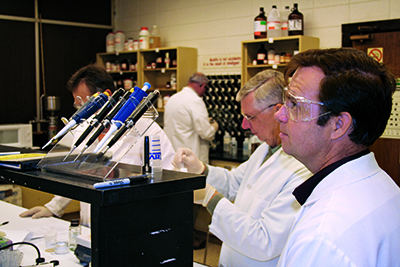
Dale Sanson, Ph.D., discusses PBI-Gordon’s SpeedZone herbicide (Photo courtesy: PBI-Gordon).
Golfdom: Recently PBI-Gordon announced there’s a new version of SpeedZone coming to market, an emulsion-in-water (EW) version. What can you tell us about this new version?
Sanson: You mentioned there’s everyday worry, worrying about if you get “The One.” Whenever you’re dealing with something that is a legacy product like SpeedZone, you want to be careful that you don’t disturb something that is already good in the market. The benefit to (the EW) is if we get to the point that we have restrictions for volatility, drift, things of that sort. We developed this as a contingency if there were ever issues with our current SpeedZone. Fifteen years ago, the technology had not quite caught up to our needs. We’re there now, we finally got there about seven years ago. Doing quite a bit of stability fieldwork we got a prototype that we thought was acceptable. We narrowed that down from a core of 50 candidates to three. We looked at these repeatedly for two to three years to make sure they were repeating what we were seeing: satisfaction with efficacy for broadleaf control and safe for turf. It finally came down to two candidates. We chose the one we thought was the candidate, and that’s the one we’re moving forward to commercialize.
Golfdom: Do you ever get exposure with your end users and discuss a product like SpeedZone?
Sanson: The best analogy I can give you is, as a parent you have children and you raise them the right way and you hope that one day they go off on their own and make you proud. I will say SpeedZone is one of those. It took a lot of work, a lot of effort, just like a child in the early days. It has left the nest, and it’s doing great. What’s really encouraging is whenever you happen to be at the Golf Industry Show and you’re walking around. You hear SpeedZone and they’re talking about it and I think, “Oh, I did that.” There’s satisfaction there.










